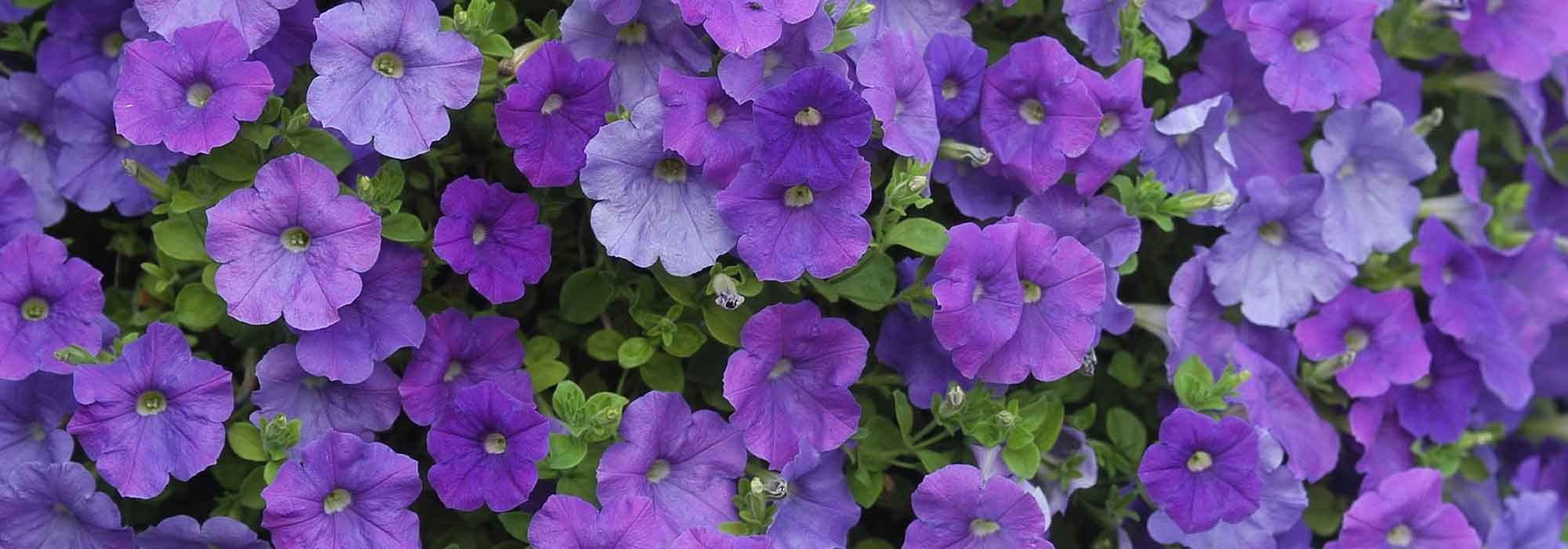
Petunia, Surfinia, Calibrachoa: planting, sowing, care
Contents
Petunias and Calibrachoa in a nutshell
- Very floriferous and fast-growing, petunias, surfinas, and calibrachoas bloom abundantly from June to October
- They provide continuous flowering for 6 months in cheerful and bright colours
- They are easy to grow in full sun, in any good humus-bearing soil, as long as you provide regular watering: a guaranteed success, almost maintenance-free!
- Frost-sensitive, they are grown as annuals in open ground or in pots to be brought indoors during winter
- Kings of hanging baskets where they cascade with single or double flowers, they are also exceptional in beds and borders
A word from our expert
Most often hung on balconies or suspended from window sills, Petunias and Calibrachoas, “Million Bells” or mini petunias, are remarkable for their generous flowering that lasts from May until the first frosts, forming a true cascade of flowers. They now rival geraniums for the splendour and duration of their flowering and often form the basis of summer flower displays.
They are perfect for all gardens, pots, hanging baskets and borders.
These tender summer-flowering plants are grown as annuals in our climates and must be stored in winter in a conservatory.
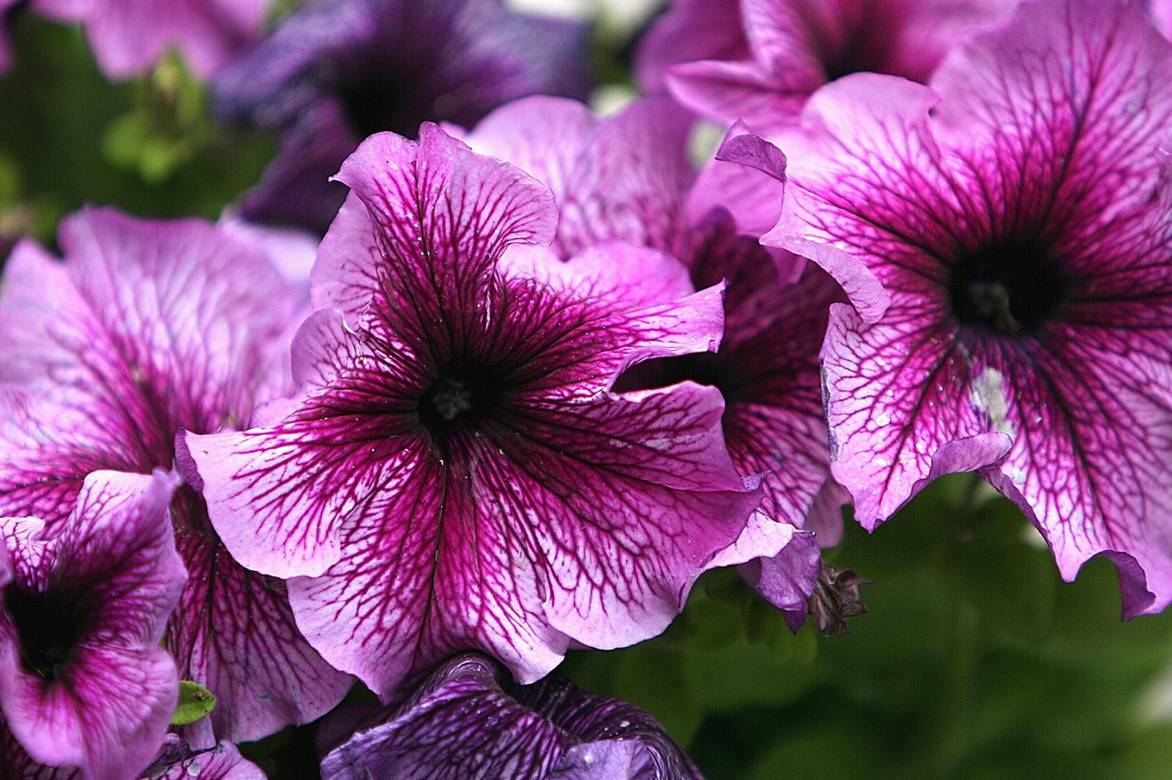
Petunia flowers.
They come in an infinite array of often bright colours, sometimes bicoloured or tricoloured, from pure white to intense black or indigo blue with all the shades of pink, red and orange.
Petunia Grandiflora with large flowers, Petunia Surfinia with a trailing habit, blue petunia or black petunia (Petunia (x) hybrida ‘blackberry’), red and orange Calibrachoa hybrids, with double or single flowers, the choice is vast and allows all gardeners, even the inexperienced, to unleash their imagination.
Easy to grow, they thrive in full sun, in any well-drained garden soil while remaining cool. They demonstrate excellent resilience to the elements and a lovely resistance to heat.
Throughout the summer, these generous and vigorous annual plants do, however, require regular and abundant watering, along with regular fertiliser applications to give their best.
From cuttings to maintenance, discover our collection of Petunias, Surfinias and Calibrachoas in plug plants as well as our unique selection of seeds! Popular, floriferous and fuss-free, they are essential in summer!
Description and Botany
Botanical data
- Latin name Petunia, Calibrachoa
- Family Solanaceae
- Common name Calibrachoa, Petunia, Surfinia
- Flowering May to October
- Height 0.10 to 2 m
- Exposure Sun, partial shade
- Soil type All, well-drained
- Hardiness -5°C to -10°C
The Petunia, Surfinia Petunia®, a hybrid of petunia, and the Calibrachoa, sometimes called “Million Bells” and often referred to as “Mini Petunia“, are frost-tender perennials often grown as annuals from the Solanaceae family, like ornamental tobacco. All three are native to the warm regions of South America and are widely appreciated in France for their long and generous flowering.
There are about 40 species of petunias and around twenty species of calibrachoa, which, although not belonging to the same botanical genus as petunia, share all its qualities. The numerous cultivars and new hybrid races, continually increasing, such as Surfinia and Supertunia or Super Bells® and Mini Famous® among calibrachoas, complement the already very diverse forms and colour palette. The varieties are classified into series: ‘Grandiflora series’, ‘Cascade series’ for petunias, ‘Noa’ and ‘Can-Can’ series for calibrachoas.
The habit varies from one species to another, but all are relatively low and spread widely. Depending on the variety, petunia can form a upright and bushy tuft with a perfect dome shape (multiflora petunias) or, conversely, display a distinctly trailing silhouette in the case of Petunia x Surfinia or trailing petunia. The grandiflora petunia has a more spreading habit.
The calibrachoa is distinguished by a habit that is always non-upright, trailing, creeping to weeping.
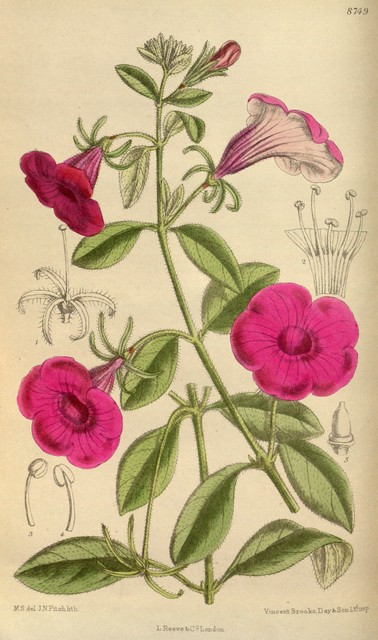
Petunia integrifolia – botanical illustration
Surfinia and Supertunia are characterised by a faster and more branched development than petunia and calibrachoa. All three quickly form a particularly vigorous tuft of 0.15 to 60 cm in height for almost as much in width. Then it spreads more or less and cascades through their long, flexible, and branched stems which can reach up to 1.20 m in length by the end of the season for Surfinia and Supertunia.
The foliage is dense and vigorous. The hairy, sturdy, and well-branched stems bear small simple ovate leaves with pointed tips. Measuring 5 to 12 cm long, they are covered with a fine velvet and slightly sticky, in a medium to dark green colour.
Very floriferous, petunias, surfinias, and calibrachoas are remarkable for their exuberant flowering and their very wide colour palette, constantly enriched by the creation of new hybrids.
The trumpet-shaped or small bell-shaped flowers in intense colours stand out against this dense foliage. Closely packed together, the flowers succeed each other tirelessly, from May until the first frosts. Ranging from 3 to 10 cm in diameter, they bloom solitarily in the axil of the upper leaves.
The size and colour of the flowers vary according to the varieties and hybrids; grandiflora petunias bear large flowers (8 to 10 cm in diameter), bushy multiflora petunias have medium-sized veined flowers that are more resistant to rain, while surfinias are the most floriferous. The milliflora calibrachoas (or Million Bells in reference to their small bell-shaped flowers) are distinguished by smaller flowers (3 to 5 cm in diameter) but come in new varieties such as ‘Super Bells’ with larger flowers that are often variegated and bicoloured, or ‘Mini Famous’ with truly stunning colours, sometimes tricoloured.
The five-lobed flowers with irregular edges bloom in the form of flared trumpets either single or double, composed of a small heart of crumpled petals that are sometimes very undulated, arranged in concentric circles.
White, pale yellow or lemon, pink, red, mauve, indigo blue, black, bicoloured, tricoloured or striated, they offer an infinity of rich, vivid, and deep or pastel colours that can sometimes border on gaudy.

Some flowers of petunias: Petunia Supertunia Bordeaux, Petunia Cascadia Indian Summer, Petunia Surfinia Blue Picotee, Petunia Tumbelina Candyfloss double pink.
They display a often unique pattern; colours arranged in rays (Calibrachoa Superbells ‘Lemon Slice’, Petunia ‘Blueberry Star’) or contrasting on the margins (Petunia Cascadias ‘Rim Magenta’), petals randomly marbled and maculate, throat enhanced by a small halo (contrasting colour heart) or a central star that brightens the colour of the corolla… The combinations and colour games are infinite.
With a fine texture, silky and velvety, the delicately veined petals of certain varieties of Calibrachoa ‘Can-Can’, for example, sometimes allow fine veins to show through the corolla.
The new variety of Calibrachoa or Mini Petunia ‘Chamaeleon’ has a changing colour that continuously varies with temperature and light.
The new series of Petunia ‘Night Sky’ presents unprecedented tones in flower colours, evoking a celestial constellation against a dark purple background.

Some flowers of Calibrachoa or mini petunia: Calibrachoa Chamaeleon Double Pink Yellow, Calibrachoa Noa Almond Blossom, Calibrachoa Chameleon Blueberry Scone, Calibrachoa MiniFamous Double PinkTastic.
This endless flowering, sometimes delicately scented in surfinias, attracts a large number of pollinating insects. Tirelessly, the new flowers replace the faded ones that fall spontaneously in calibrachoas.
These are frost-tender perennials that fear frost (-8 °C maximum) and are therefore often grown as annuals in our climates. Easy to grow, drought and heat resistant, petunias and calibrachoas appreciate sheltered from the wind, well-sunny situations like bright partial shade.
Very floriferous and fast-growing, they need a light and fertile but especially well-drained soil that is not too dry. They are essential plants for balconies and terraces, magnificent in hanging baskets, window boxes, or pots, but the excellent hold of their flowers also allows for planting in the ground, where they form lovely borders for flower beds or paths.
Main species and varieties
Since more than a century, petunias have been the subject of thorough selection by breeders. In the 1990s, many hybrids emerged, as evidenced by the Supertunia with its long flowering stems (1.20 m), of which Surfinia remains the most well-known and widely cultivated.
Petunias are divided into 4 main groups: grandiflora petunias with large flowers, multiflora petunias with medium flowers, milliflora petunias with small flowers, and trailing petunias (Surfinia, Fortunia).
Petunias form a dense and ramified tuft that is more or less compact depending on the variety, and they are especially appreciated in borders and beds. Surfinias have a unique habit, both compact and trailing with flowering cascades, absolutely perfect for hanging baskets.
These hybrid races complement an already diverse palette of colours, sometimes featuring unusual varieties like ‘Petunia Night Sky’ with its fascinating and truly unique colours among flowers.
Closely related to petunias, calibrachoas, considered mini-petunia types, have smaller bell-shaped flowers (hence their nickname “Million Bells”, one of the first hybrids). Since then, calibrachoa series have multiplied, such as Super Bells®, Mini-Famous® or Noa®. They now come in a multitude of colours, with single or double flowers, sometimes bicoloured or tricoloured…
The current trend is to offer collections of 3 or 5 varieties of petunias, Surfinia, and calibrachoas, mixed in the same pot, combining different colours.
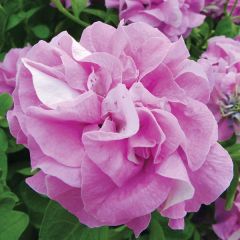
Surfinia Double Lilac Petunia
- Flowering time July to November
- Height at maturity 30 cm

Petunia Surfinia Tumbelina Maria
- Flowering time July to November
- Height at maturity 30 cm

Petunia Surfinia Deep Red
- Flowering time June to November
- Height at maturity 25 cm

Petunia Surfinia Giant Blue
- Flowering time June to November
- Height at maturity 25 cm

Petunia Surfinia Snow
- Flowering time July to November
- Height at maturity 30 cm
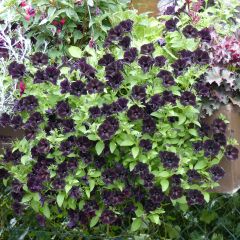
Petunia Black Ray
- Flowering time June to November
- Height at maturity 40 cm

Petunia Super Cascade Improved
- Flowering time July to November
- Height at maturity 30 cm
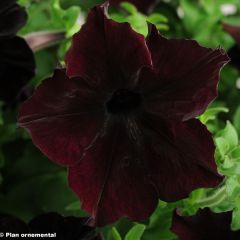
Petunia hybrida Sophistica Blackberry
- Flowering time July to November
- Height at maturity 40 cm

Petunia Night Sky
- Flowering time June to November
- Height at maturity 25 cm

Petunia Supertunia Picasso in Pink
- Flowering time June to November
- Height at maturity 25 cm
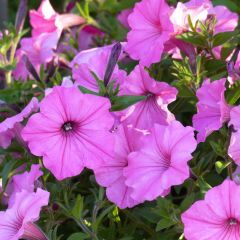
Petunia Supertunia Vista Bubblegum
- Flowering time July to November
- Height at maturity 40 cm
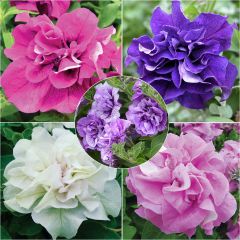
Collection of 5 Double Surfinia Petunias
- Flowering time July to November
- Height at maturity 40 cm
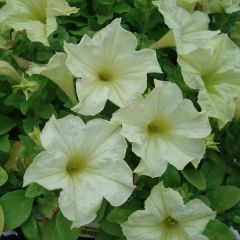
Petunia Sophistica Lime Green
- Flowering time July to November
- Height at maturity 40 cm
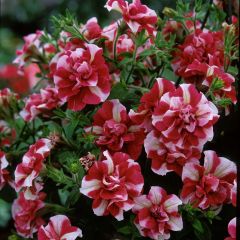
Petunia Tumbelina Cherry Ripple
- Flowering time June to November
- Height at maturity 30 cm
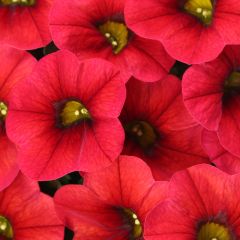
Calibrachoa Lia Dark Red - Mini-Petunia
- Flowering time June to November
- Height at maturity 20 cm
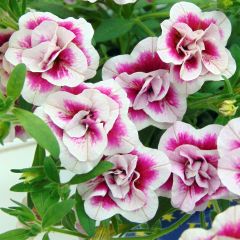
Calibrachoa MiniFamous Double PinkTastic - Double Mini-Petunia
- Flowering time July to October
- Height at maturity 40 cm
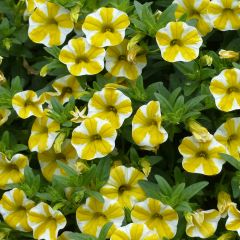
Calibrachoa Superbells Lemon Slice - Mini-Petunia
- Flowering time July to November
- Height at maturity 50 cm

Calibrachoa Can-Can Rosies Blue - Double Mini-Petunia
- Flowering time July to October
- Height at maturity 50 cm
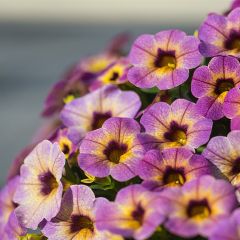
Calibrachoa Chameleon Blueberry Scone - Mini-Petunia
- Flowering time July to October
- Height at maturity 30 cm
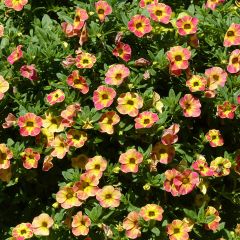
Calibrachoa Chameleon Sunshine Berry - Mini-Petunia
- Flowering time July to October
- Height at maturity 30 cm

5 double Calibrachoa or Mini-petunias collection
- Flowering time July to November
- Height at maturity 50 cm
Discover other Petunia and Surfinia
View all →Available in 1 sizes
Available in 2 sizes
Available in 2 sizes
Available in 2 sizes
Available in 2 sizes
Available in 1 sizes
Available in 2 sizes
Available in 1 sizes
Available in 2 sizes
Available in 1 sizes
Planting
Where to Plant Petunias, Surfinas, and Calibrachoas
These frost-sensitive perennials are vulnerable to cold, and frost is fatal to them. They cannot withstand temperatures below -8°C, which is why, in our climates, they are usually grown as annuals in the ground or in pots. Some petunias and calibrachoas can withstand light frosts (-5 to -8°C), so you can try to keep your pots in an unheated greenhouse, protected from frost in winter, to bring them out during the beautiful season outside!
Most varieties tolerate bad weather, rain, and heat well. However, calibrachoas have a better drought resistance than their petunia cousins.
Plant them in full sun and sheltered from the wind; these plants need at least 6 hours of sunlight per day to be very floriferous. In the south of our country, they will accept partial shade.
Their cultivation is easy, but Petunias, Surfinas, and calibrachoas are greedy! Provide them with a light, humus-bearing, and well-drained soil. They prefer soils that remain fairly cool but will not tolerate stagnant moisture.
Install these beautiful annual plants in large pots, balcony boxes on the terrace or balcony, in hanging baskets, above a low wall (prefer Surfinas!), anywhere their flowering stems (especially trailing petunias!) can cascade. They are also good plants for a conservatory or patio.
“Mass” petunias also find their place in perennial or annual flower beds, in large flowering patches, or to punctuate ephemeral path borders. When not contained, Surfinas develop into dense, flowering carpets and can also form a bushy ground cover at the foot of shrubs or roses.
When to Plant Petunia, Surfinia, and Calibrachoa Plants
Plant our young petunia plants and calibrachoas in plug plants in the ground or in pots, when the risk of severe frosts has passed, in April-May. In the meantime, you can pre-cultivate them in pots to hasten their growth, in a warm and bright place (conservatory, greenhouse, cold frame…) at a temperature above 14°C before installing them outside.
How to Plant Petunias and Calibrachoas
Upon receipt, transplant and store our young petunia plants and calibrachoas in plug plants under cover (conservatory, greenhouse, cold frame…) at a temperature above 14°C. Allow them to gain strength for a few weeks before installing them outside after the last frosts.
In the Ground
Plant about 5 to 6 plug plants of Petunias, Surfinas, or calibrachoas per m². Space the plants 30 to 40 cm apart in all directions. In a bed, you can plant in numbers to achieve a beautiful, highly floriferous mass. Plant them in a staggered pattern. These are very greedy plants, improve your soil with compost. The substrate should be fertile and well-draining.
- Soak the pots for 1 or 2 hours before planting
- Prepare the ground with shallow digging
- Dig a hole 2 to 3 times larger than the size of the plug
- Make a good bed of gravel or clay balls for perfect drainage
- Mix the extracted soil with geranium compost and coarse sand
- Place the plug plant in the centre of the hole, with the collar level with the soil
- Bring the soil back to encase the roots
- Firm down with your foot
- Water generously
How to Plant a Petunia or Calibrachoa in a Pot or Hanging Basket
All petunias and calibrachoas are the kings of hanging baskets, window boxes, bowls, or pots from which they cascade up to 1.20 m in height! Plant in a rich, well-draining mixture of geranium-type compost and river sand.
Choose a container of at least 25 cm in diameter per plant. In a mixture, space the plants 20-25 cm apart for a dense and lively composition.
- Soak the plugs well before planting
- Line the bottom of the container with gravel or clay balls
- Plant in compost, optionally adding a bit of compost
- Fill and firm down
- Water abundantly, then whenever the soil dries on the surface
- Fertilise regularly and place in the sun
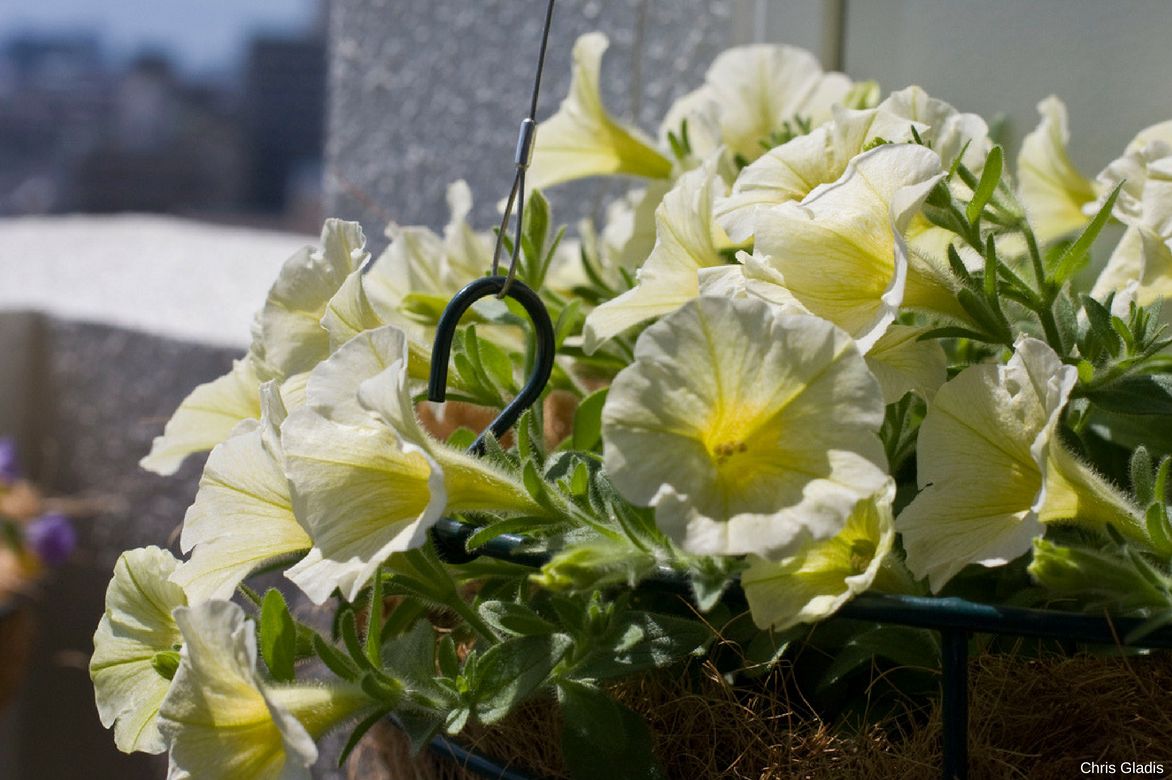
A lovely hanging basket adorned with a pale yellow petunia.
Read also
Planting annualsWhen and how to sow Petunia seeds?
Our Petunia seeds are sown in trays or pots from February to April at a temperature of 21 to 25 °C. However, these seeds as fine as dust, barely visible to the naked eye, make sowing rather reserved for very experienced gardeners who are accustomed to sowing very fine seeds. Be aware, petunia sowing can be somewhat temperamental, we recommend instead our plug plants of Petunias and mini-petunias which are much easier!
How to sow our petunia seeds
- Sow Petunia seeds on the surface of good seed compost
- Lightly cover the seeds with compost or vermiculite
- Lightly press down
- Seal them in a polythene bag and place in light in a warm spot between 21 and 25°C
- Keep the substrate moist but not waterlogged until germination, which usually takes 10 to 21 days
- When the seedlings are sufficiently developed, at the stage of 3 or 4 true leaves, keep them warm
- In mid-May, after all risk of frost has passed, transplant them into the ground, pots, or window boxes
- Add a good amount of compost to each planting hole
Maintenance, pruning and care of Petunias and Calibrachoas
Petunias, Surfinias and calibrachoas are very floriferous annual plants that are generous as long as the soil is regularly fertilised with fertiliser and they are well watered! Most varieties withstand bad weather and heat well.
- The fertiliser
Add liquid fertiliser for flowering plants, such as “geraniums”, to the watering water once or twice a week throughout the growth period. In open ground, a scratching in spring with a mixture of dried blood and ground horn at the base of the plant will suffice. Abundance is guaranteed!
- Watering
Watering must be regular, even daily during hot summer weather, but not excessive as they are sensitive to excess moisture, which causes root rot. A petunia grown in a container, hanging basket or pot requires more water than a petunia in open ground: allow the soil to dry out between waterings. In all cases, do not wet the foliage or flowers.
How to prune petunias
Remove faded flowers from petunias as they appear to prolong flowering. Calibrachoas, unlike petunias, do not need to be pruned during the season; their flowers fall off spontaneously after flowering without the need for pruning.
At the end of summer, cut back some stems to a third or half of their height to encourage new floriferous branching.
If your petunias are less floriferous during the summer, cut them back to 20 cm from the ground, and they will produce new flowers two weeks later.
Petunias and calibrachoas wither at the first frost. In cold regions, from November, pull up the plants from open ground. In regions with mild winters, cut back to 10 cm from the ground at the end of flowering and then spread a mineral mulch which, unlike a plant mulch, will not retain too much moisture at the base of the plant.
If you wish to keep your pots for winter, store them in a frost-free place in an unheated conservatory, to bring them out the following spring. Cut the plant back to ground level, mulch and water approximately once every 15 days.
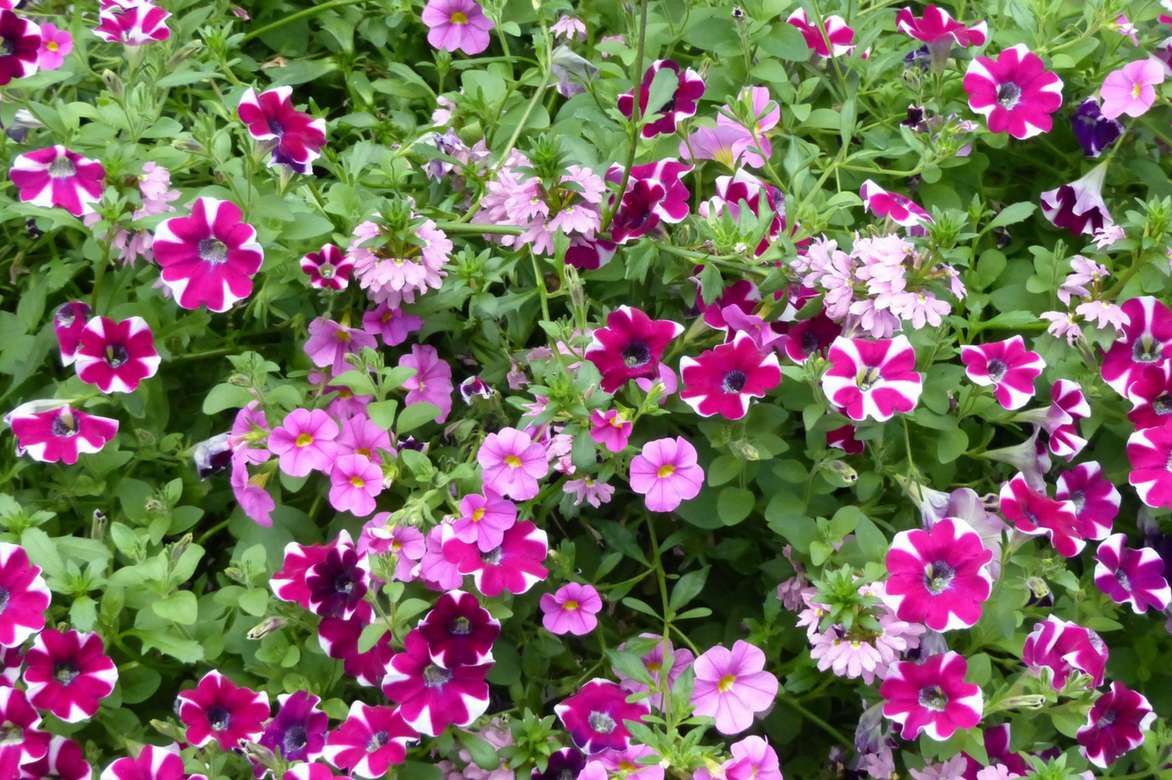
Mélange of Petunia ‘Cascadias Bicolor Cabernet’, pink calibrachoa and Scaevola ‘Pink Fashion’
Pests and potential diseases
A well-ventilated location helps to prevent many fungal diseases to which petunias and other calibrachoas are susceptible. These fungi can rot the roots and completely destroy a plant within a few weeks. Absolutely avoid excess water and always allow the soil to dry out between waterings. In case of infection: uproot and burn it.
In case of excess lime, these plants may be threatened by chlorosis, which discolours the leaves and weakens the plants: favour waterings with non-lime rainwater. If your soil is too alkaline: add heather soil during planting.
Petunias can suffer from attacks by aphids and whiteflies during the summer: install trap plants like nasturtiums nearby and shorten the infested stems by a third or half.
Slugs love the young foliage of petunias: discover our tips for combating gastropods!
Also read Marion’s advice in Diseases and Pests of Petunias and Surfinas.
Propagation
How to take cuttings of Petunias and Calibrachoa?
- Mid-August, take stem tips with 2 or 3 nodes but without flowers, about 15 cm long
- Cut each stem into sections just below a node
- Remove the lower leaves, keeping only 2 upper leaves
- Plant your cuttings 1 or 2 cm deep in buckets filled with a light mix of potting soil and sand
- Water regularly but do not flood the substrate
- Place the cuttings in light and warmth (minimum 20 °C – 25 °C)
- At the beginning of spring, repot the cuttings
- Plant them in the ground or in pots in May after the last frosts
Pairing Petunias
With their bright or pastel colours, Petunias and Calibrachoas or mini petunias are among those essential annual plants for hanging baskets, window boxes, flower beds or borders. They adapt to all desires, whether in the ground or in pots, in all city gardens, natural or naturalistic gardens, or romantic settings, creating often very colourful displays.
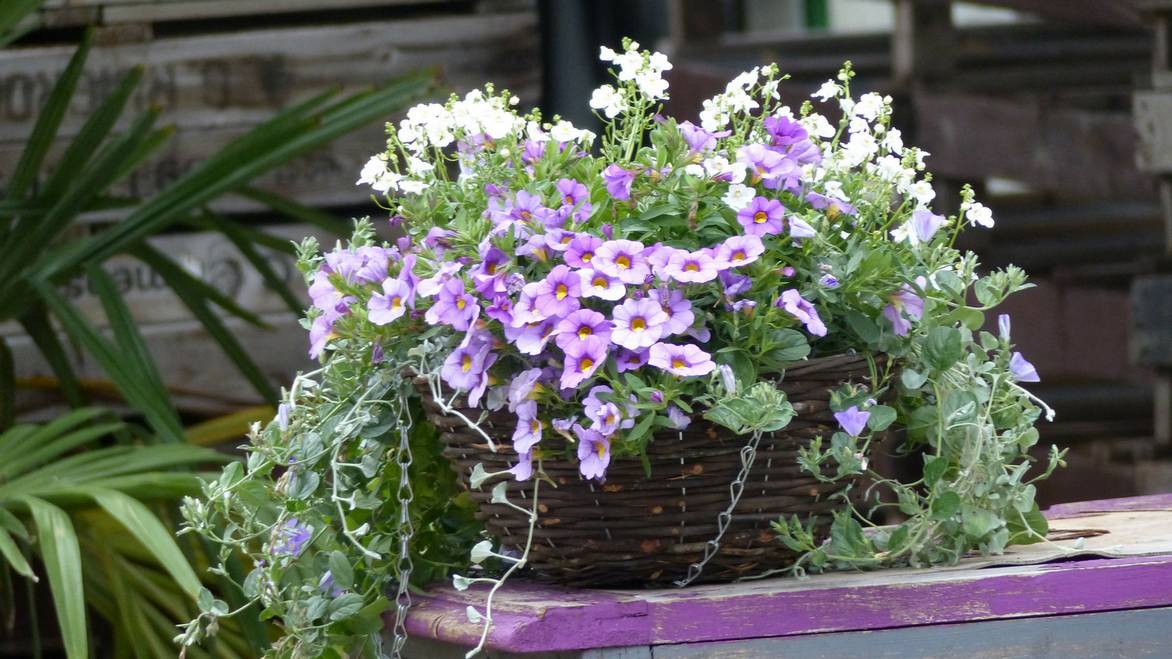
An example of a basket combination: Calibrachoa ‘Unique Lavender’, Diascia ‘Genta Classic White’.
While they often stand alone beautifully in hanging baskets and mix wonderfully with each other, they are also very easy to pair with other summer flowers, perennials or summer-flowering bulbs.
Current hybrids offer an infinite variety of vibrant and unique colours allowing for endless combinations, contrasting, in gradients or monochromatic, elegant or bold.
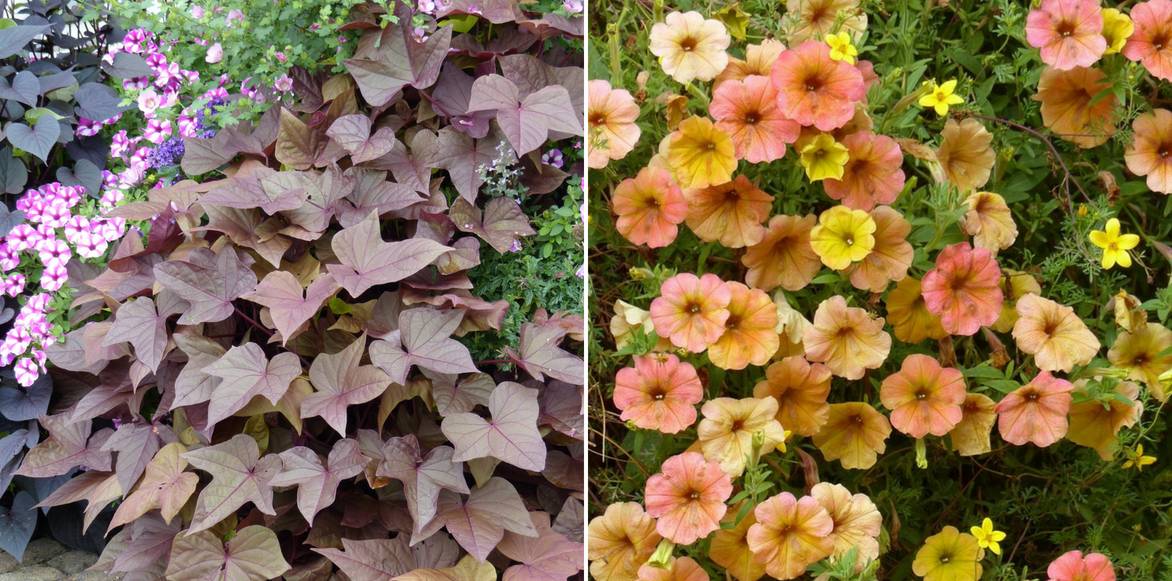
An idea for a combination: Ipomea ‘Sweet Caroline Bronze’, Petunia ‘Cascadias Indian Summer’.
In a flower bed, with ivy geraniums and pelargoniums, they will hide the bare stems of modern bush roses throughout the beautiful season: plant several s in the same shades to create an original ground cover and avoid overly garish combinations. They are remarkable when paired with Verbena and Nemesia.
In the foreground of summer flower beds, they will be highlighted when combined with Cleomes, Bidens and Gaillardes, Rudbeckias or Cosmos.
You can also plant them to enliven borders of grey-leaved plants such as Nepeta, annual poppies, Cerastium, Helichrysum, sea cineraria or Artemisia.
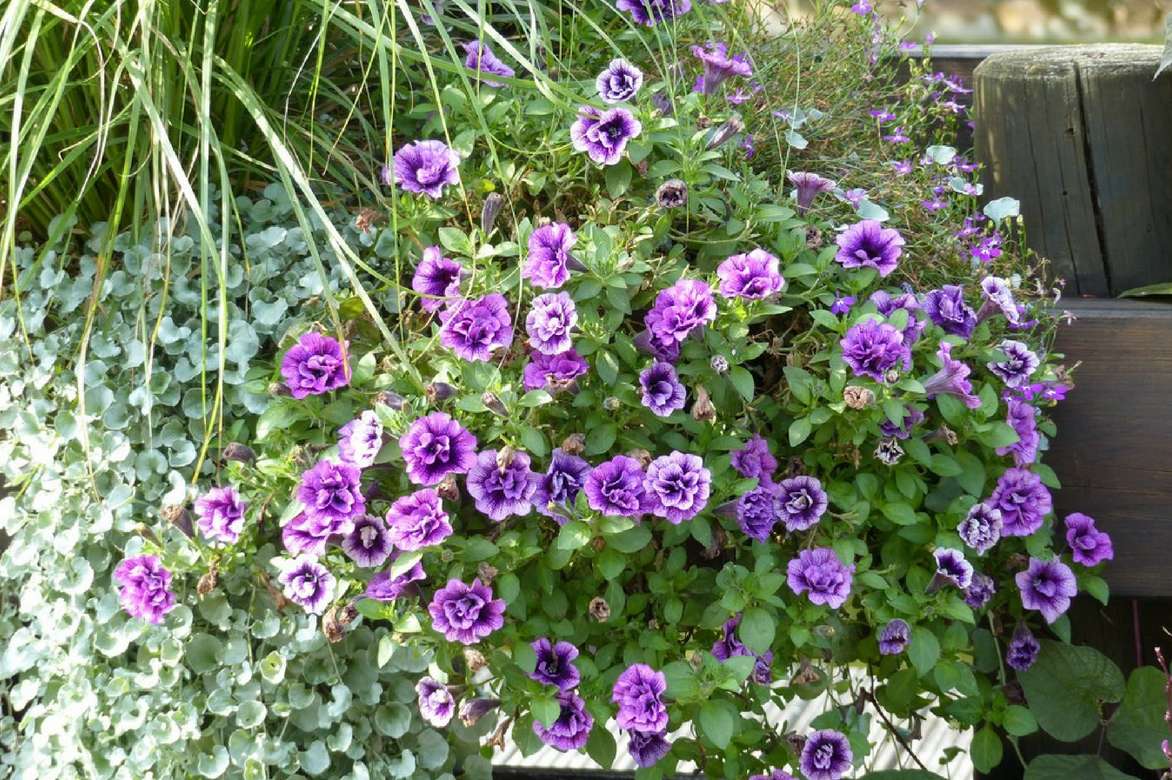
An example of a combination: Petunia ‘Sugar Plum’, Dichondra ‘Silver Falls’ and a grass such as Carex testacea ‘Lime Shine’ to add lightness.
They thrive wonderfully in the foreground of a flower bed with small Agapanthus and Fescue.
In pots, mix them with other annual plants such as Impatiens, fragrant alyssum, Ipomoea, Mandevilla, dwarf nasturtiums, Lobelia and geraniums.
Useful resources
- Petunias and Calibrachoas are easy to combine: choose their companions from our unique collection of annual plants
- Discover our selection of 7 Surfinas and Petunias to brighten up your terrace or garden
- Discover our best ideas to flower your balconies and terraces
- Annual plants dress up the space they are given in just a few weeks: discover our solutions!
- Check out our 7 pairing ideas to create beautiful summer planters
- Subscribe!
- Contents
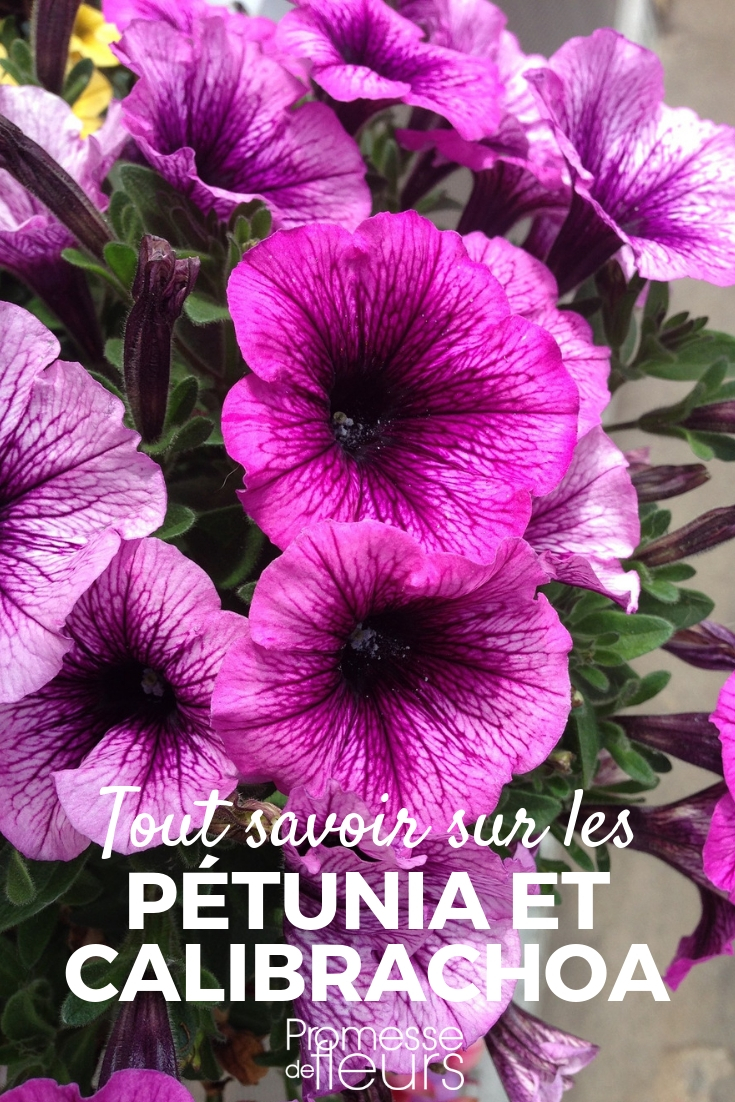

































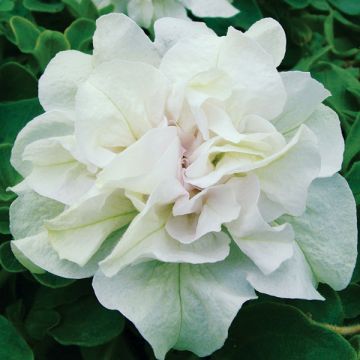

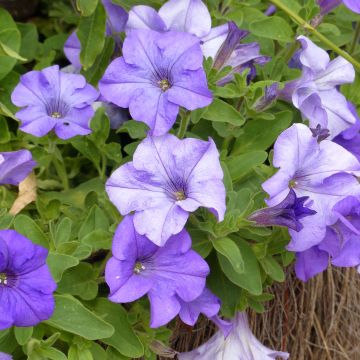
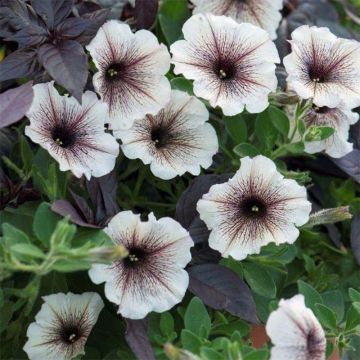




Comments